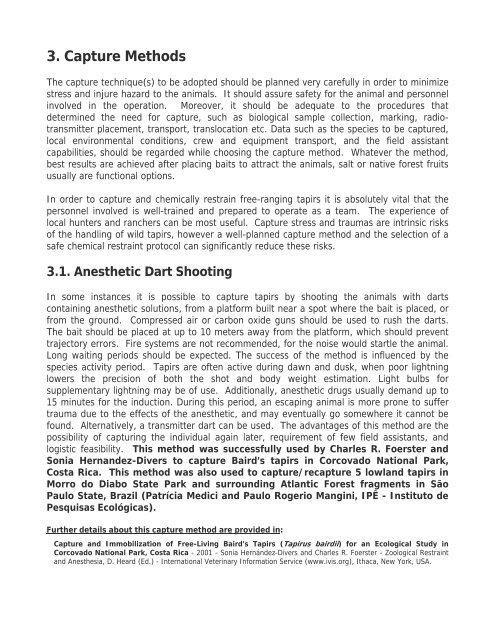TAPIR FIELD VETERINARY MANUAL - Tapir Specialist Group
TAPIR FIELD VETERINARY MANUAL - Tapir Specialist Group
TAPIR FIELD VETERINARY MANUAL - Tapir Specialist Group
You also want an ePaper? Increase the reach of your titles
YUMPU automatically turns print PDFs into web optimized ePapers that Google loves.
3. Capture Methods<br />
The capture technique(s) to be adopted should be planned very carefully in order to minimize<br />
stress and injure hazard to the animals. It should assure safety for the animal and personnel<br />
involved in the operation. Moreover, it should be adequate to the procedures that<br />
determined the need for capture, such as biological sample collection, marking, radiotransmitter<br />
placement, transport, translocation etc. Data such as the species to be captured,<br />
local environmental conditions, crew and equipment transport, and the field assistant<br />
capabilities, should be regarded while choosing the capture method. Whatever the method,<br />
best results are achieved after placing baits to attract the animals, salt or native forest fruits<br />
usually are functional options.<br />
In order to capture and chemically restrain free-ranging tapirs it is absolutely vital that the<br />
personnel involved is well-trained and prepared to operate as a team. The experience of<br />
local hunters and ranchers can be most useful. Capture stress and traumas are intrinsic risks<br />
of the handling of wild tapirs, however a well-planned capture method and the selection of a<br />
safe chemical restraint protocol can significantly reduce these risks.<br />
3.1. Anesthetic Dart Shooting<br />
In some instances it is possible to capture tapirs by shooting the animals with darts<br />
containing anesthetic solutions, from a platform built near a spot where the bait is placed, or<br />
from the ground. Compressed air or carbon oxide guns should be used to rush the darts.<br />
The bait should be placed at up to 10 meters away from the platform, which should prevent<br />
trajectory errors. Fire systems are not recommended, for the noise would startle the animal.<br />
Long waiting periods should be expected. The success of the method is influenced by the<br />
species activity period. <strong>Tapir</strong>s are often active during dawn and dusk, when poor lightning<br />
lowers the precision of both the shot and body weight estimation. Light bulbs for<br />
supplementary lightning may be of use. Additionally, anesthetic drugs usually demand up to<br />
15 minutes for the induction. During this period, an escaping animal is more prone to suffer<br />
trauma due to the effects of the anesthetic, and may eventually go somewhere it cannot be<br />
found. Alternatively, a transmitter dart can be used. The advantages of this method are the<br />
possibility of capturing the individual again later, requirement of few field assistants, and<br />
logistic feasibility. This method was successfully used by Charles R. Foerster and<br />
Sonia Hernandez-Divers to capture Baird’s tapirs in Corcovado National Park,<br />
Costa Rica. This method was also used to capture/recapture 5 lowland tapirs in<br />
Morro do Diabo State Park and surrounding Atlantic Forest fragments in São<br />
Paulo State, Brazil (Patrícia Medici and Paulo Rogerio Mangini, IPÊ - Instituto de<br />
Pesquisas Ecológicas).<br />
Further details about this capture method are provided in:<br />
Capture and Immobilization of Free-Living Baird’s <strong>Tapir</strong>s (<strong>Tapir</strong>us bairdii) for an Ecological Study in<br />
Corcovado National Park, Costa Rica - 2001 - Sonia Hernández-Divers and Charles R. Foerster - Zoological Restraint<br />
and Anesthesia, D. Heard (Ed.) - International Veterinary Information Service (www.ivis.org), Ithaca, New York, USA.










